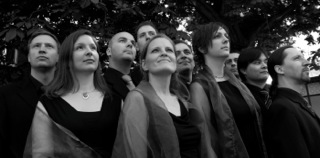by Nicholas Jones

The program was entitled Stabat Mater, a reference to the medieval poem which portrays the sorrows of Mary. Baroque in its intensity (“I want to stand beside the cross with you and join you in weeping”), the highly dramatic text predates by some centuries the similarly emotional laments that Bach set in his passions and cantatas.
Driving to the concert, I couldn’t help thinking of the most often-performed Stabat Mater, by the early 18th-century composer G. B. Pergolesi, a beautiful if lachrymose setting. But Vox Luminis gave us instead Domenico Scarlatti’s little-known version, equally affecting but less sentimental. Scarlatti is known primarily as a composer of elegant and witty harpsichord sonatas, but in a completely different vein, this is a piece with a remarkable range of affect and expression. The work comprised the whole of the second half.
Scarlatti wrote the piece for ten different vocal parts. Vox Luminis sang it one singer to a part, supported by organ and gamba. Weaving a complex tapestry out of the ten individual voices, the group sang with utter mastery and coherence. Particularly impressive was the exquisite intonation, allowing the ensemble to pile suspension upon suspension and still return to perfect consonance.
Since the group’s first CD in 2007 featured the Scarlatti, it is perhaps no surprise that the choir delivered the work’s swift changes of affect with complete confidence. As a result, the audience — obviously enraptured — could participate in the lament’s demanding emotional range, which moved without break through expressions of sorrow, anger, lamentation, serenity, and even joy.
The founder of Vox Luminis, the French bass Lionel Meunier, led the group with subtle and effective gestures while singing in the ensemble. The singers are all of solo quality, but they consistently used their voices in ways that gave first priority to choral blend and produced a striking confluence of tone and mood.
The first half of the program foreshadowed Scarlatti’s sorrowful mother with a series of varied songs dealing with women’s anguish, both religious and secular. The opening piece was an anonymous 13th-century lamentation of Mary, sung from out of sight by one or two sopranos (the resonant acoustics and the singers’ remarkable blend left me unsure how many voices were singing). In early medieval music, we rarely hear singers in full voice, but at the climax of this beautiful piece, the singer(s) let loose, so we could feel not only Mary’s sadness but also her anger and bitterness, expressed with spine-chilling fervor.
In a program about the sorrows of love, it makes perfect sense to bring in the master of anguish and joy, Monteverdi, even in his secular vein. Three madrigals describing the bitterness of unrequited love gave other soloists the chance to shine, including two fine countertenors. The third madrigal was Monteverdi’s well-known Lamento della Ninfa from the Eighth Book, sung by a solo soprano with backup choir. It was notable for its operatic spaciousness and demanding emotional arc.
The last piece in the first half was another lament in the voice of the Virgin, by an amateur 17th-century composer named Alessandro della Ciaia. It was performed with conviction and skill, but (at least on first hearing) its highly-strung rhetoric lacked the precision of the Monteverdi that preceded it and the sweep of the Scarlatti that followed.
Coming to Cleveland at the end of a whirlwind US tour (six cities in eight days!), the eleven singers and two instrumentalists of Vox Luminis might well have been exhausted. Perhaps Halloween candy and the warm welcome of the audience revived any flagging spirits, for the musicians were clearly engaged and in top form. Kudos to the St. John’s for bringing in this innovative vocal ensemble, the second in this year’s remarkable lineup for the Cathedral’s Helen D. Schubert Concerts.
(An end note: be sure to read Alex Ross’s recent review of Peter Sellar’s tragic St. Matthew Passion in The New Yorker, Oct. 27.)
Published on ClevelandClassical.com November 4, 2014.
Click here for a printable copy of this article


